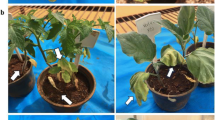Abstract
Samples of tubers collected from commercial potato seed lots produced across North America were assayed forVerticillium dahliae. V. dahliae was successfully isolated from 65 of 224 seed lots tested, a successful isolation rate of nearly 30%. Vegetative compatibility of the isolates was assessed through complementation tests using nitrate non-utilizing mutants. AllV. dahliae isolates belonged to vegetative compatibility group (VCG) 4. Of the 162 isolates recovered, 64% belonged to VCG 4A, 33% to VCG 4B, and 3% to VCG 4AB. All 39 of the isolates tested in the greenhouse on potato cv. Superior were pathogenic to potato. Disease symptoms developed earlier, were more severe, and plants died earlier when inoculated with VCG 4A compared to 4B isolates. As a group, AUSPC values were significantly higher (p=0.05) for VCG 4A than for 4B isolates. These data suggest that (1) commercial certified seed tubers from diverse locations are commonly infected withV. dahliae and thus may serve as primary sources of the pathogen; (2) potato isolates ofV. dahliae in North America belong to VCG 4A and 4B and these strains are widely distributed via seed tubers; and (3) VCG 4A and 4B are distinct pathotypes ofV. dahliae that vary in their aggressiveness to potato.
Similar content being viewed by others
Literature Cited
Ashworth, L.J. 1983. Aggressiveness of random and selected isolates ofVerticillium dahliae from cotton and the quantitative relationship of internal inoculum to defoliation. Phytopathology 73:1292–295.
Ben-Yephet, Y., Z.R. Frank, J.M. Malero-Vera, and J.E. DeVay. 1989. Effect of crop rotation and metham-sodium onVerticillium dahliae.In: Tjamos, E.C., and C.H. Beckman (eds) Vascular Wilt Diseases of Plants: Basic Studies and Control. Springer-Verlag, New York. pp. 543–546.
Bosland, P.W. and P.H. Williams. 1987. An evaluation ofFusarium oxysporum from crucifers based on pathogenicity, isozyme polymorphism, vegetative compatibility, and geographic origin. Can J Bot 65:2067–2073
Botseas, D.D. and R.C. Rowe. 1994. Development of potato early dying in response to infection by two pathotypes ofVerticillium dahliae and co-infection byPratylenchus penetrans. Phytopathology 84:275–282.
Campbell, C. L. and L.V. Madden. 1990. Introduction to Plant Disease Epidemiology. John Wiley and Sons, Inc., New York.
Chen, W. 1994. Vegetative compatibility groups ofVerticllium dahliae from ornamental woody plants. Phytopathology 84:214–219.
Correll, J.C., C.J.R. Hittich, and J.F. Leslie. 1987. Nitrate nonutilizing mutants ofFusarium oxysporum and their use in vegetative compatibility tests. Phytopathology 77:1640–1646.
Corsini, D.L., J.R. Davis, and J.J. Pavek. 1985. Stability of resistance of potato to strains ofVerticillium dahliae from different vegetative compatibility groups. Plant Dis 69:980–982.
Daayf, F., M. Nicole, and J. Geiger. 1995. Differentiation ofVerticillium dahliae populations on the basis of vegetative compatibility and pathogenicity on cotton. Eur J Plant Pathol 101:69–79.
Elmer, W.H. and C.T. Stephens. 1989. Classification ofFusarium oocysporum f. sp.asparagi into vegetatively compatible groups. Phytopathology 79:88–93
Grogan, R.G., N. Ioannou, R.W. Schneider, M.A. Sall, and K.A. Kimble. 1979. Verticillium wilt on resistant tomato cultivars in California: Virulence of isolates from plants and soil and relationship of inoculum density to disease incidence. Phytopathology 69:1176–1180.
Heale, J.B. 1988.Verticillium spp., the cause of vascular wilts in many species.In: Sidha, G.S. (ed). Genetics of Plant Pathogenic Fungi, Advances in Plant Pathology 6:291–312. Academic Press, New York.
Jeger, M.J., G.A. Hide, P.H. Van Den Boogert, A.J. Termorshuizen, and P. Van Baarlen. 1996. Pathology and control of soil-borne fungal pathogens of potato. Pot Res 39:437–469.
Joaquim, R.R. and R.C. Rowe. 1990. Reassessment of vegetative compatibility relationships among strains ofVerticillium dahliae using nitrate-nonutilizing mutants. Phytopathology 80:1160–1166.
Joaquim, R.R. and R.C. Rowe. 1991. Vegetative compatibility and virulence of strains ofVerticillium dahliae from soil and potato plants. Phytopathology 81:552–558.
Korolev, N. and T. Katan. 1997. Improved medium for selecting nitrate nonutilizing mutants ofVerticillium dahliae. Phytopathology 87:1067–1070.
Leslie, J.F. 1993. Fungal vegetative compatibility.In: Cook, R.J., G.A. Zentmyer, and G. Shaner (eds.). Annu Rev Phytopathol 31:127–150.
MacGuidwin, A.E. and D.I. Rouse. 1990. Role ofPratylenchus penetrans in the potato early dying disease of Russet Burbank potato. Phytopathology 80:1077–82.
Okoli, C.A.N., J.H. Carder, and D.J. Barbara. 1993. Molecular variation and subspecific groupings withinVerticillium dahliae. Mycol Res 97:233–239.
Powelson, M.L. and R.C. Rowe. 1993. Biology and management of early dying of potatoes.In: Cook, R.J., G.A. Zentmyer, and G. Shaner (eds). Annu. Rev. Phytopathol. 31:111–126.
Powelson, M.L. and R.C. Rowe. 1994. Potato early dying: Causes and management tactics in the eastern and western United States.In: Zehnder, G.W., M.L. Powelson, R.K. Jansson, and K.V. Raman (eds). Advances in Potato Pest Biology and Management. APS Press. St. Paul, MN. pp. 178–190
Puhalla, J.R. and M. Hummel. 1983. Vegetative compatibility groups withinVerticillium dahliae. Phytopathology 73:1305–1308.
Rowe, R.C. 1995. Recent progress in understanding relationships betweenVerticillium species and subspecific groups. Phytoparasitica 23:31–38.
Rowe, R.C., J.R. Davis, M.L. Powelson, and D.I. Rouse. 1987. Potato early dying: Causal agents and management strategies. Plant Dis 71:482–489.
Rowe, R., M. Omer, and D. Johnson. 1998. North American potato seed lots—A primary source ofVerticillium? Am J Potato Res 75:295. (abstr.)
Rowe, R.C. R.M. Riedel, and M.J. Martin. 1985. Synergistic interactions betweenVerticillium dahliae andPratylenchus penetrans in potato early dying disease. Phytopathology 75:412–418.
Strausbaugh, C.A. 1993. Assessment of vegetative compatibility and virulence ofVerticillium dahliae isolates from Idaho potatoes and tester strains. Phytopathology 83:1253–1258.
Strausbaugh, C.A., M.N. Schroth, A.R. Weinhold, and J.G. Hancock. 1992. Assessment of vegetative compatibility ofVerticillium dahliae tester strains and isolates from California potatoes. Phytopathology 82:61–68.
Typas, M.A., A.M. Griffen, B.W. Bainbridge, and J.B. Heale. 1992. Restriction fragment length polymorphisms in mitochondrial DNA and ribosomal RNA gene complexes as an aid to the characterization of species and sub-species populations in the genusVerticillium. FEMS(Fed Eur Microbiol Soc) Microbiol Lett 95:157–162.
Wheeler, T.A., R.C. Rowe, R.M. Riedel, and L.V. Madden. 1994. Influence of cultivar resistance toVerticillium spp. on potato early dying. Am Potato J 71:39–57.
Author information
Authors and Affiliations
Rights and permissions
About this article
Cite this article
Omer, M.A., Johnson, D.A. & Rowe, R.C. Recovery ofVerticillium dahliae from North American certified seed potatoes and characterization of strains by vegetative compatibility and aggressiveness. Am. J. Pot Res 77, 325–331 (2000). https://doi.org/10.1007/BF02853954
Accepted:
Issue Date:
DOI: https://doi.org/10.1007/BF02853954



